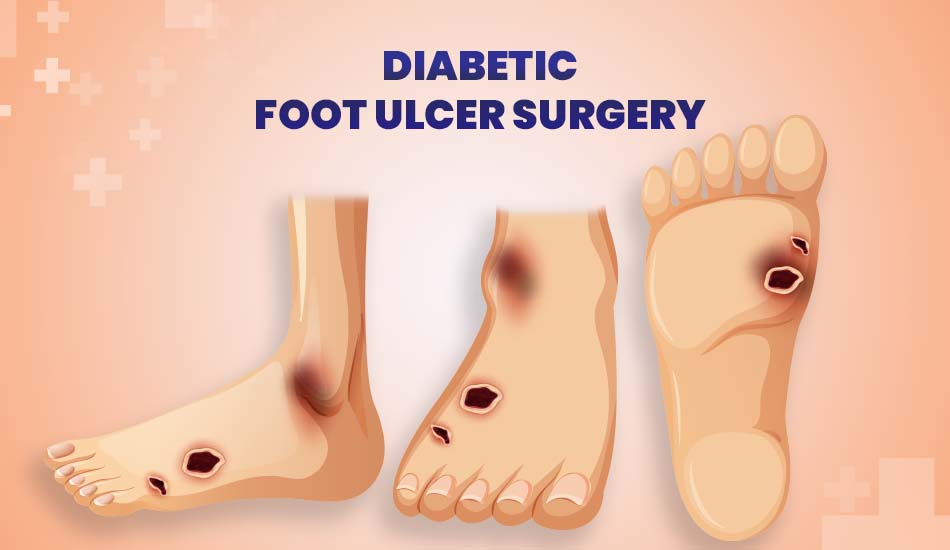
Diabetic Foot Ulcer Surgery: Steps, Recovery Tips, and Success Stories
Thursday, 23rd May 2024Diabetic foot ulcers are a serious complication of diabetes that can lead to severe infections and, in some cases, require surgical intervention. Understanding the steps involved in diabetic foot ulcer surgery, as well as tips for recovery, can help patients navigate the healing process more effectively. This article provides an in-depth look at diabetic foot ulcer surgery, recovery tips, and real patient success stories.
Understanding Diabetic Foot Ulcers
A diabetic foot ulcer is an open sore or wound that occurs in approximately 15% of patients with diabetes. These ulcers typically form on the bottom of the foot and can become infected if not treated properly. Poor circulation, high blood sugar levels, and nerve damage are contributing factors that make healing more difficult for people with diabetes.
When is Surgery Necessary?
Surgery for diabetic foot ulcers may be necessary when:
- The ulcer does not heal with conservative treatments.
- There is severe infection that threatens the foot.
- There is significant tissue damage or necrosis.
- The ulcer has exposed bone or tendon.
Steps Involved in Diabetic Foot Ulcer Surgery
1. Pre-Surgery Assessment
Before surgery, a thorough assessment is conducted to evaluate the extent of the ulcer and the patient's overall health:
- Medical History Review: The surgeon reviews the patient's medical history and current medications.
- Physical Examination: A detailed examination of the foot, including the ulcer and surrounding tissue.
- Imaging Tests: X-rays, MRI, or CT scans to assess bone involvement and the extent of infection.
- Blood Tests: To check blood sugar levels, kidney function, and other relevant parameters.
2. Surgical Planning
Based on the assessment, the surgical team plans the procedure:
- Debridement: Removal of dead or infected tissue to promote healing.
- Revascularization: Surgery to improve blood flow to the affected area, if poor circulation is a factor.
- Amputation: In severe cases, partial or complete amputation may be necessary to prevent the spread of infection.
3. The Surgical Procedure
The specifics of the surgery depend on the individual case:
- Debridement Surgery: The surgeon removes necrotic tissue and cleans the ulcer thoroughly.
- Reconstructive Surgery: May involve skin grafts or flaps to cover large ulcers.
- Amputation: If needed, the surgeon removes the affected part of the foot or leg, followed by wound closure and preparation for a prosthesis if necessary.
4. Post-Surgery Care
Post-surgery care is crucial for successful recovery:
- Wound Care: Keeping the surgical site clean and dry, with regular dressing changes.
- Medication: Antibiotics to prevent infection and pain management medications.
- Blood Sugar Control: Strict monitoring and management of blood sugar levels to promote healing.
- Physical Therapy: To aid in mobility and rehabilitation, especially after amputation.
Recovery Tips for Diabetic Foot Ulcer Surgery
Follow Medical Advice
Adhering to your doctor’s instructions is vital for a successful recovery:
- Wound Care: Follow the wound care regimen prescribed by your healthcare provider.
- Medications: Take all prescribed medications as directed, including antibiotics and pain relievers.
Maintain Blood Sugar Levels
Good blood sugar control is essential for healing:
- Monitor Regularly: Check your blood sugar levels frequently and keep them within the target range.
- Healthy Diet: Eat a balanced diet rich in nutrients to support healing and overall health.
Avoid Pressure on the Affected Foot
Minimizing pressure on the surgical site can prevent complications:
- Use Assistive Devices: Crutches or a wheelchair can help keep weight off the affected foot.
- Footwear: Wear specialized shoes or orthotics designed to reduce pressure on the foot.
Regular Follow-Up Appointments
Attend all scheduled follow-up appointments to monitor healing and address any issues promptly:
- Wound Check: Regular inspections of the wound by your healthcare provider.
- Adjustments: Necessary changes to your treatment plan based on healing progress.
Lifestyle Modifications
Making lifestyle changes can support recovery and prevent future ulcers:
- Quit Smoking: Smoking impairs blood flow and healing, so quitting is crucial.
- Exercise: Engage in low-impact exercises to improve circulation and overall health.
- Foot Care: Inspect your feet daily for signs of new ulcers or other issues.
Success Stories: Real Patient Experiences
Michael’s Journey to Recovery
Michael, a 55-year-old with type 2 diabetes, developed a severe foot ulcer that required surgery: "I was terrified when my doctor said I needed surgery, but the procedure went smoothly. The care I received afterward was excellent, and I followed every instruction to the letter. Today, my foot has healed well, and I'm back to my daily walks, more cautious but grateful."
Lisa’s Triumph Over Complications
Lisa, a 60-year-old with long-standing diabetes, faced multiple complications from her foot ulcer: "The infection had spread, and amputation seemed inevitable. But my surgical team was incredible. They performed a partial foot amputation and worked tirelessly on my rehabilitation. It was a tough journey, but I'm now walking with a prosthesis and feel like I've got my life back."
John’s Story of Prevention and Healing
John, a 45-year-old with type 1 diabetes, learned the importance of prevention after his surgery: "My ulcer wasn't healing, and surgery was the only option. Post-surgery, I learned so much about preventing future ulcers. I'm meticulous about my foot care now, and the education from my healthcare team has been invaluable."
Conclusion
Diabetic foot ulcer surgery can be a critical step in preventing severe complications and promoting healing. Understanding the steps involved, adhering to recovery tips, and drawing inspiration from success stories can help patients navigate this challenging journey. If you have a diabetic foot ulcer, consult with a healthcare provider to explore your surgical options and develop a comprehensive care plan to support your recovery and long-term health.


